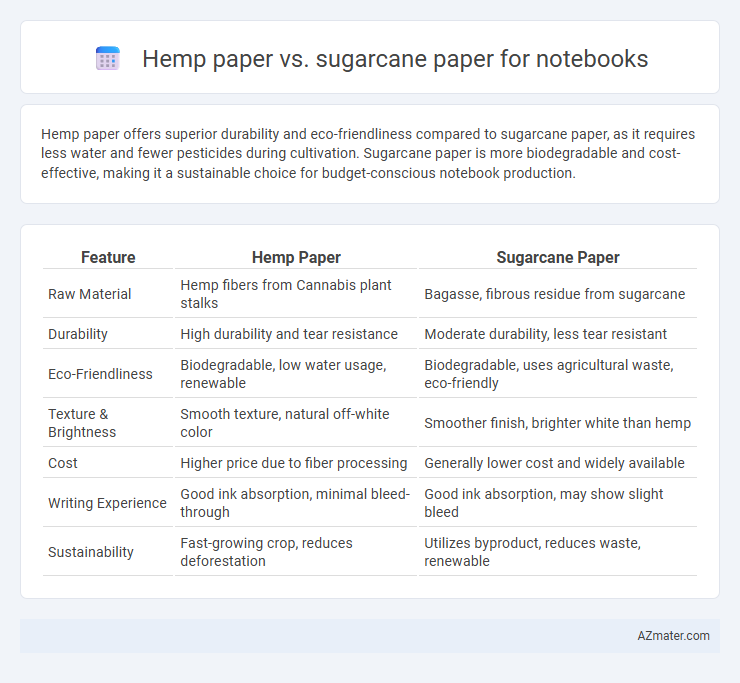Hemp paper offers superior durability and eco-friendliness compared to sugarcane paper, as it requires less water and fewer pesticides during cultivation. Sugarcane paper is more biodegradable and cost-effective, making it a sustainable choice for budget-conscious notebook production.
Table of Comparison
| Feature | Hemp Paper | Sugarcane Paper |
|---|---|---|
| Raw Material | Hemp fibers from Cannabis plant stalks | Bagasse, fibrous residue from sugarcane |
| Durability | High durability and tear resistance | Moderate durability, less tear resistant |
| Eco-Friendliness | Biodegradable, low water usage, renewable | Biodegradable, uses agricultural waste, eco-friendly |
| Texture & Brightness | Smooth texture, natural off-white color | Smoother finish, brighter white than hemp |
| Cost | Higher price due to fiber processing | Generally lower cost and widely available |
| Writing Experience | Good ink absorption, minimal bleed-through | Good ink absorption, may show slight bleed |
| Sustainability | Fast-growing crop, reduces deforestation | Utilizes byproduct, reduces waste, renewable |
Introduction to Sustainable Paper Alternatives
Hemp paper offers exceptional durability and requires significantly less water and pesticides compared to traditional wood pulp, making it a highly sustainable alternative for notebooks. Sugarcane paper utilizes agricultural waste, converting bagasse into a fiber source that reduces landfill waste and lowers carbon emissions during production. Both materials contribute to eco-friendly notebook options by promoting resource efficiency and reducing environmental impact.
Hemp Paper vs Sugarcane Paper: Overview
Hemp paper offers superior durability and sustainability due to its high cellulose content and rapid growth cycle, making it an eco-friendly alternative to sugarcane paper. Sugarcane paper, produced from bagasse, provides cost-effective production with a lower environmental impact than traditional wood pulp but generally lacks the strength and longevity of hemp paper. Both materials support sustainable practices, but hemp paper excels in texture and longevity for premium notebook production.
Environmental Impact: Hemp vs Sugarcane
Hemp paper production uses significantly less water and pesticides compared to sugarcane paper, reducing environmental pollution and conserving resources. Sugarcane paper often relies on bagasse, a byproduct of sugar extraction, which promotes waste utilization but may still involve chemical treatments that impact ecosystems. Overall, hemp's rapid growth cycle and lower chemical input make it a more sustainable choice for eco-friendly notebooks.
Raw Material Sourcing and Availability
Hemp paper is made from the fast-growing fibers of the Cannabis sativa plant, which can be harvested multiple times a year, offering a highly sustainable raw material source with consistent availability. Sugarcane paper is produced using bagasse, the fibrous residue left after extracting juice from sugarcane, which leverages agricultural waste but is dependent on seasonal sugarcane harvest cycles. Both materials reduce reliance on traditional wood pulp, but hemp's year-round growth potential provides a more reliable raw material supply compared to sugarcane's seasonal byproduct availability.
Production Process Comparison
Hemp paper production involves harvesting mature hemp stalks, retting to separate fibers, followed by mechanical or chemical pulping to create a durable, eco-friendly pulp. Sugarcane paper is produced by utilizing bagasse, the fibrous residue from sugar extraction, which undergoes pulping and bleaching for a sustainable alternative to wood paper. Both processes emphasize renewable raw materials but differ in fiber extraction techniques and environmental impact.
Paper Quality and Durability
Hemp paper offers superior durability due to its long and strong fibers, resulting in less tearing and increased resistance to wear compared to sugarcane paper. Sugarcane paper, while eco-friendly and smooth in texture, generally has shorter fibers, making it less robust and more prone to damage over time. For notebook use, hemp paper maintains consistent quality and longevity, providing a sturdier writing surface ideal for frequent handling.
Printing and Writing Performance
Hemp paper offers superior durability and smoothness, resulting in less ink bleed and sharper print quality, which enhances the writing experience in notebooks. Sugarcane paper, while environmentally friendly, tends to have a rougher texture that can cause slight ink absorption variation, affecting fine detailing in prints and handwriting. Both papers support various printing techniques, but hemp paper excels in maintaining clarity and crispness for detailed notes and drawings.
Cost Efficiency and Market Pricing
Hemp paper offers higher durability and faster growth cycles compared to sugarcane paper, but its production costs remain significantly elevated due to limited farming and processing infrastructure. Sugarcane paper benefits from abundant agricultural byproducts and established supply chains, resulting in lower manufacturing costs and more competitive market pricing for notebooks. Cost efficiency analysis shows sugarcane paper notebooks appeal to budget-conscious consumers, while hemp paper notebooks target premium segments with sustainability-driven value propositions.
Biodegradability and Recycling Potential
Hemp paper exhibits superior biodegradability due to its natural fiber composition, breaking down faster in composting environments compared to sugarcane paper, which often contains residual chemicals from processing. Recycling potential of hemp paper is higher because its long fibers maintain strength through multiple recycling cycles, whereas sugarcane paper's shorter fibers tend to degrade faster during recycling. Both materials contribute to sustainable notebook production, but hemp's enhanced biodegradability and durability in recycling make it the more eco-friendly option.
Choosing the Best Eco-Friendly Notebook Paper
Hemp paper offers superior durability and requires less water and pesticides to produce compared to traditional wood-based paper, making it a sustainable choice for eco-friendly notebooks. Sugarcane paper, derived from bagasse, a byproduct of sugar production, repurposes agricultural waste and lowers carbon footprint, appealing to environmentally conscious consumers. Selecting the best eco-friendly notebook paper involves evaluating factors like recyclability, production impact, and resource efficiency, where both hemp and sugarcane papers present compelling green alternatives.

Infographic: Hemp paper vs Sugarcane paper for Notebook
 azmater.com
azmater.com